

Photo Journeys
Travel photography and travel articles by Robin & Arlene Karpan

Photographing the Amazing Whooping Crane Migration in Saskatchewan
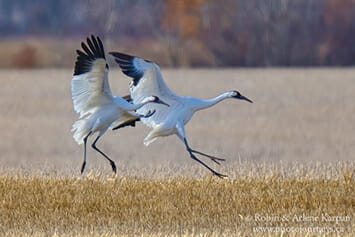
Table of Contents
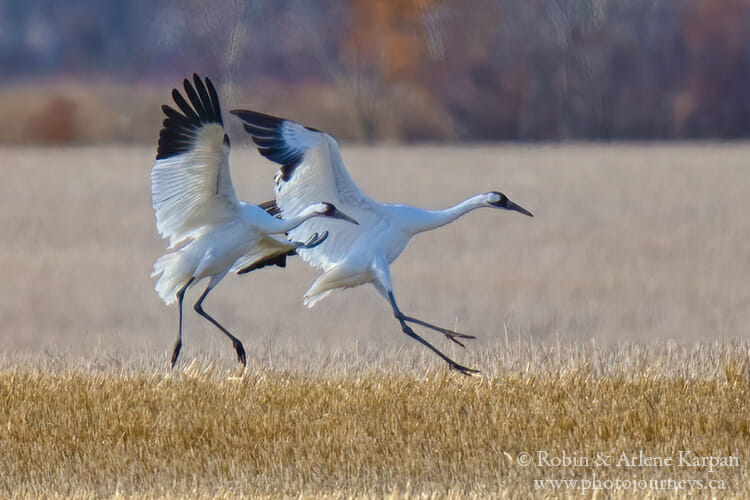
Saskatchewan is a hotspot for seeing and photographing whooping cranes, one of the rarest and most famous endangered birds in North America. Each fall these magnificent white birds migrate around 4,000 km from their nesting grounds in Wood Buffalo National Park, straddling the Alberta / Northwest Territories border, to their winter home in Aransas National Wildlife Refuge on the Texas Gulf Coast. They fly a direct and fairly narrow route, with their favourite stop along to rest and feed along the way being south-central Saskatchewan. Normally, they arrive around early to mid-October.
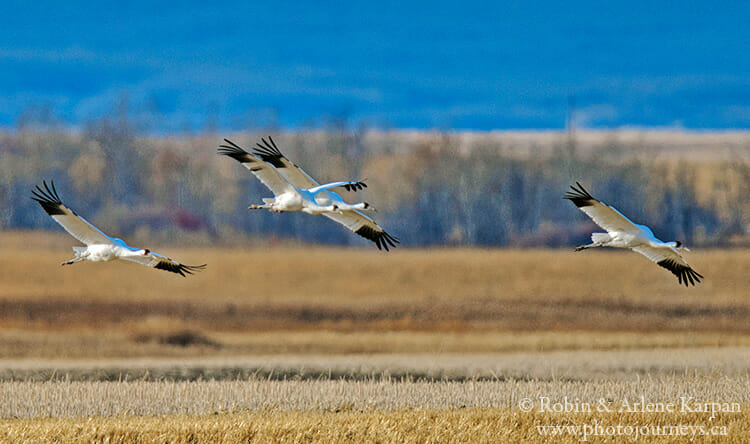
Exactly where they stop may vary from year to year, but it has usually been within an hour or so drive from our home in Saskatoon. Some places they tend to favour include Last Mountain Lake National Wildlife Area (North America’s oldest bird sanctuary), Muskiki Lake, Radisson Lake, and the pothole country southeast of Saskatoon.
In recent years the top hotspot has been the area around Blaine Lake and Marcelin, almost straight north of Saskatoon. They favour these places because of the combination of wetlands and nearby grain fields that make it handy for feeding. Typically they don’t all travel together, so it might be possible to find clusters of whoopers in different spots.
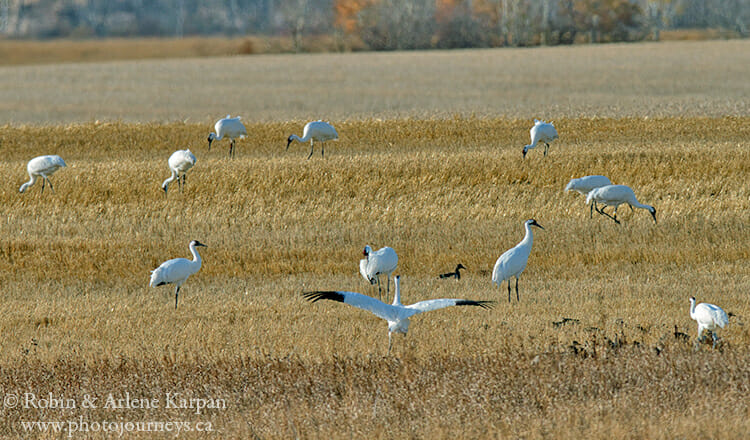
Back From the Brink, A Whooping Crane Success Story
Whooping cranes have come back from the brink of extinction. The population dropped to only 14 adult birds in the early 20th century. With conservation efforts in Canada and the United States, their numbers gradually recovered. Recent population estimates are over 500 birds.
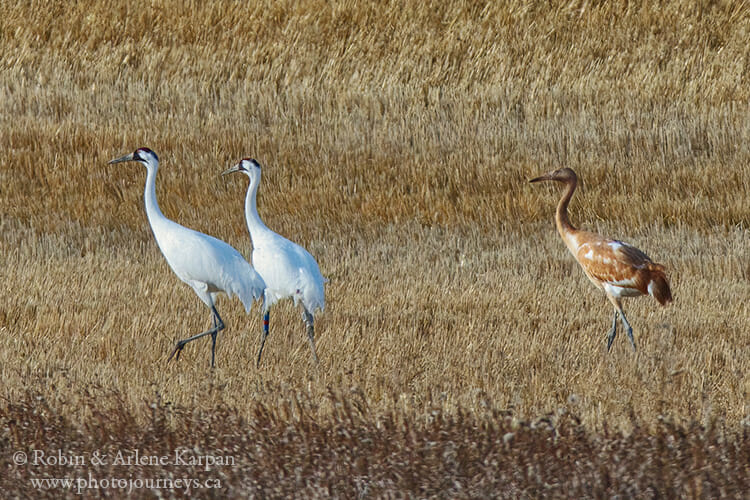
How to Recognize Whooping Cranes
Adults, with their pure white plumage and black wing tips visible in flight, can reach 1.5 metres in height — North America’s tallest bird. Their wing span can top an amazing two metres, yet this impressive bird weighs just over 7 kg. Immature youngsters are only slightly smaller and have reddish-cinnamon plumage. Their unmistakable call sounds like a bugle, with trumpet-like tones carrying far into the distance.
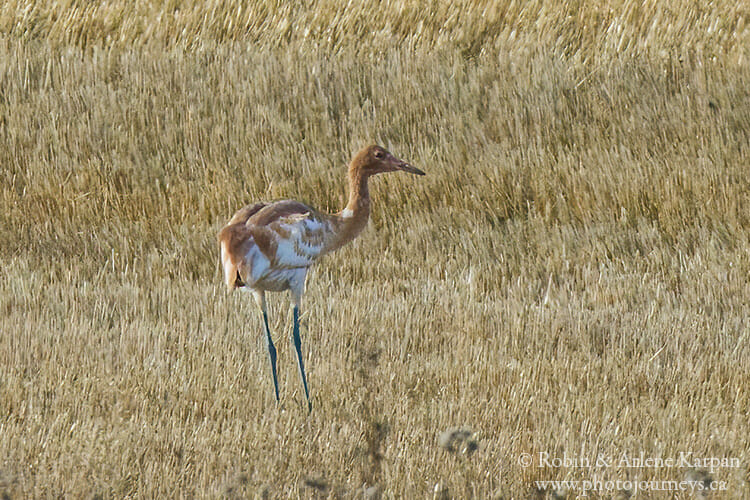
Whoopers Arriving in Larger Numbers
Only a few years ago, it was common to see small numbers of cranes at a time. But more recently we can usually find them in larger groups. On one photo trip this year, we could see 43 birds at once, plus there were certainly more in other parts of the field.
While seeing larger flocks is certainly more rewarding for birdwatchers and photographers, scientists have expressed concern that if a large flock were to suffer from a disease or an unexpected weather event, it could potentially wipe out a significant part of the total population.
One explanation for the larger flocks is not only that the total population has increased, but also because of disappearing wetlands, especially in the southern Great Plains of the United States. With fewer suitable wetlands, more birds are forced into fewer places.
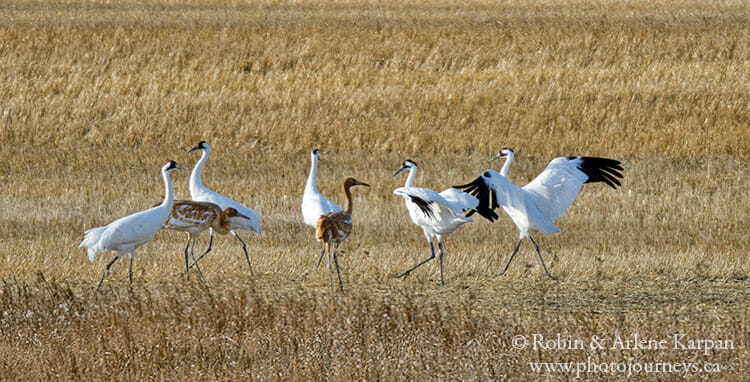
Whooping Cranes Are a Challenge to Photograph
Whoopers aren’t easy to photograph. They won’t tolerate people getting anywhere near. They like to feed in grain fields on their way south. The mostly open nature of this setting adds to the challenge, since there is often nowhere to hide to watch or photograph. The best strategy is to photograph from inside your vehicle on the side of the road, although this doesn’t always work. While they get used to traffic going by on the road, a car that stops might cause them to move away.
We had the most success during this year’s migration by finding a place to stop with bushes along the roadside. I could then walk into the bush and set up a tripod near the fence line of the field, while still being obscured by the trees. The cranes were still a long distance away and they never changed their behavior. I used a 600mm lens, but even with that I had to crop the images a fair amount when processing.
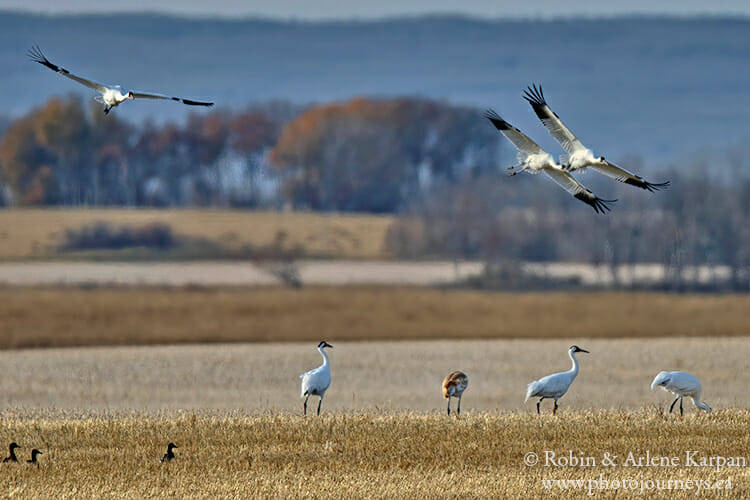
The whoopers tended to move around a lot. They would feed in one spot then slowly walk to another area. Every so often some made a fuss by flapping their wings at other birds. While most were in the same general area, they were fairly dispersed with small groups or a couple of birds, and even individuals off by themselves. Occasionally some would fly to another part of the field just a few hundred metres away.
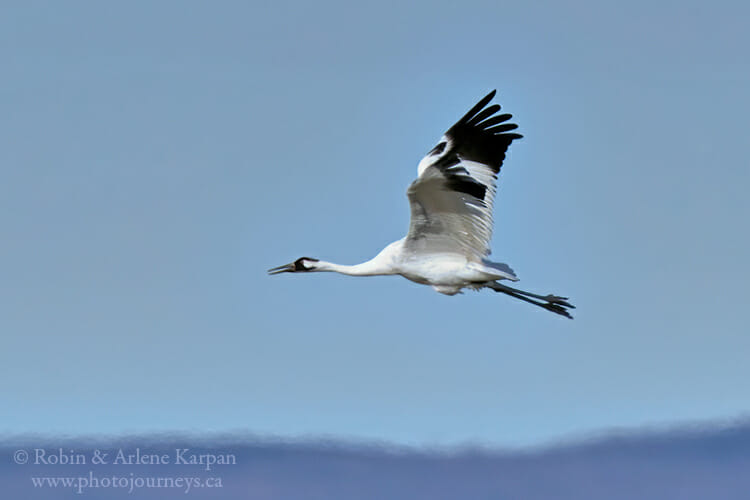
These short flights provided some of the best photo opportunities. They flew low and slow, gracefully gliding much of the way. As they came in for a landing, their feet came down and the wings tipped up as they almost did a running landing to slow down. Despite the challenges, watching and photographing these iconic birds ranks among Saskatchewan’s great outdoor adventures.
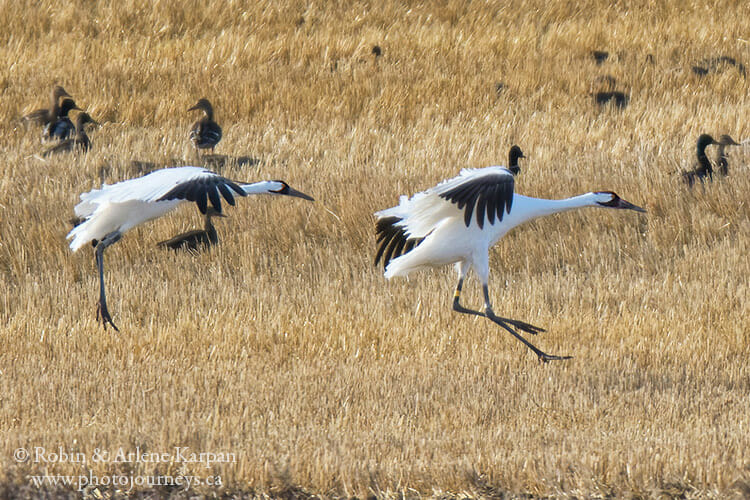
For more information on whooping crane identification, migration, protection, and conservation see Friends of the Wild Whoopers ., a conservation group based in the United States.
Feel free to PIN this article on Whooping Crane Migration in Saskatchewan
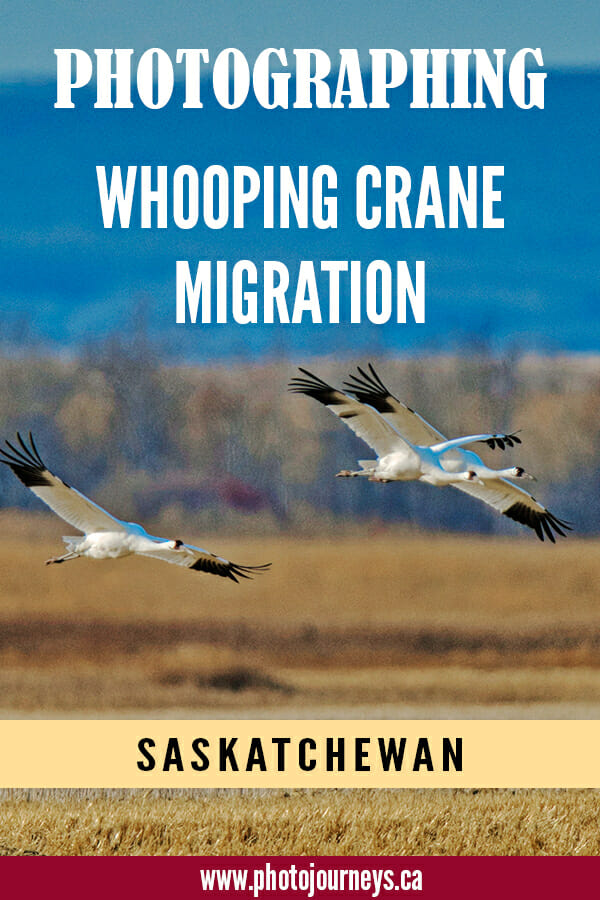
4 thoughts on “ Photographing the Amazing Whooping Crane Migration in Saskatchewan ”
An excellent article and we love our whooping cranes. The photos are fabulous! Thank you for posting. Pam Bates VP-FOTWW
Thank you for writing us Pam. We have included a link to your organization Friends of the Wild Whoopers in the article. Thanks for the good work you do.
Thanks for sharing your photos and wisdom on the Whoopers. Guy Wapple and Bob Holtsman are friends of mine and they speak highly of you. I was lucky and blessed to go with Guy and a few friends a week ago and see the big white birds for the first time. Spectacular and your post on them further my learning a great deal.
Highest regards’
We appreciate your comments Todd, and we’re glad you enjoyed the article.
Leave a Reply Cancel reply
Your email address will not be published. Required fields are marked *
- Create account
- Español (Latin America)
- Español (Spain)
- Português (Portugal)
- Português (Brasil)
"Once they leave here, they move on a daily, or every-second-day basis, going south," says Canadian Wildlife Service biologist Brian Johns, Canadian coordinator of the Canada-U.S. whooping crane recovery team.
People interested in observing whooping cranes in the wild can sign up for one of the interpretive tours provided by Schroeder (306-584-9668), or Nature Saskatchewan (306-975-3042). But with a little planning, a dollop of information and a touch of good luck, the whoopers can be found without the service of a guide. Here's what you need to know:
Whoopers don't migrate en masse; they trickle out of their breeding grounds in family units, and in small groups of sub-adults and non-breeders.
Sub-adults are first to leave Wood Buffalo, arriving in Saskatchewan as early as the middle of August.
"These are last year's young," explains Johns, who's based in Saskatoon . "Some years we don't get them until later on in September, and other years (like 1998) they show up in mid August.
"The larger number of birds will start moving down any time after the middle of September. The breeding birds usually start arriving here any time after the first of October."
Johns suspects the southern migration may get underway a week earlier than normal this year. A slightly premature northern migration and a warm Canadian spring effectively place the whoopers a week ahead of schedule.
One of the best sites for spotting sub-adults and non-breeders is Last Mountain Lake National Wildlife Area, the oldest bird sanctuary in North America, located on the north end of the lake about an hour and a half northwest of Regina (phone 306-836-2022 or 306-836-4461 for directions).
If you'd prefer to try to observe a breeding pair with a fledgling, your best bet is to begin by phoning Johns' Whooping Crane Hotline, at 306-975-5595. Anyone who spots a whooping crane is asked to report it by phoning this number.
The hotline was implemented to keep biologists north and south of the border abreast of the migration, as well as to warn provincial officials of areas where whooping cranes are seen with their sandhill counterparts during sandhill crane hunting season, which runs through September and October. But Johns says he's pleased to offer help to people who simply want to observe or photograph the birds.
Family groups of whooping cranes prefer smaller wetland areas, and Johns says they might choose a different staging area from one year to the next.
However, one particular mating pair is a frequent visitor to the west end of Radisson Lake, about 70 kms northwest of Saskatoon and perhaps three kms west of the Town of Radisson, just off the Yellowhead Highway (No. 16). The tiny lake is visible but unnamed on provincial highway maps.
"That pair are there, almost on an annual basis," says Johns. "Some years they'll just be there by themselves, or with their young. . . . About two years ago, there were about a dozen birds, all within a mile of each other, just northwest of Radisson Lake."
Another fertile area for whooping-crane viewing is Blaine Lake (the lake, not the town of the same name), as well as the area surrounding it. Blaine Lake, actually two bodies of water, is located about an hour north-northwest of Saskatoon.
Saskatoon residents have a very good viewing opportunity right in their own back yard. It's the area south of Highway No. 5 and north of the Yellowhead, and bordered on the east and west by Highway No. 2 and the city.
"It's the area roughly bound by Colonsay, Meacham, St. Denis and Saskatoon," says Johns. "That block quite often has birds. Almost on an annual basis."
Tour operator Schroeder says he's had good luck at Muskiki Lake, about 25 kms north of Meacham.
Whooping cranes typically leave the shallow water where they sleep around sunrise and fly out to a nearby grain field to feed. They may go back and forth during the day. Or they may remain in the water from 10 a.m. to 4 p.m., and then return to fields until sundown.
"Morning and late afternoon is their activity time," says Johns.
Schroeder has a pointer for approaching the birds in a vehicle.
"Often when you stop, that's when they watch. If you drive right past them, they think nothing of it."
"The birds impose that 400-metre distance on you. Get closer and they're likely to fly away."
One last point: If you spot a whooping crane in an area that wasn't mentioned on the Whooping Crane Hotline; give Johns a call and report your finding. You'll be doing the birds a good turn.
For more on whooping cranes, and the international effort to save them, please see Whoopers .
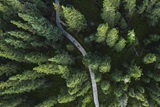
Saskatoon Custom Bird Tours
Saskatoon Custom Bird Tours offers full day, half-day and multiple day guided birding trips throughout Saskatchewan. Tours are based out of Saskatoon and the tours can include viewing of whooping cranes, dancing sharp-tailed grouse, prairie grassland birds, ducks, geese, boreal forest songbirds, wintering snowy owls, great grey owls, northern hawk owls and more. Prime birding locations include Prince Albert National Park, Grasslands National Park, Last Mountain Lake Bird Sanctuary, Chaplin, Quill Lakes, Saskatoon, provincial parks and more. Over 35 organized tours are hosted by local birding expert, Stan Shadick with Saskatoon Custom Bird Tours each year. Private bookings are also an option.

Travel Offers
- Contact Information

Chaplin Shorebirds Day Tour
Chaplin, Chaplin Lake, Saskatoon, Reeds Lake
May 10, 2024 to Sep 10, 2024
Chaplin Lake Important Bird Area and nearby lakes often have the greatest variety of plovers, sandpipers, dowitchers, phalaropes and other shorebirds in Saskatchewan, including the endangered Piping Plover. This full-day, self-drive escorted tour, offered by Saskatoon Custom Bird Tours and led by local birding expert, Stan Shadick, takes in the best shorebird habitats in Saskatchewan at Chaplin Shorebird Reserve as well as four other nearby hotspots.
The tour begins in Saskatoon but can also be joined at Elbow or Chaplin. Situated on Trans-Canada Highway 1, Chaplin serves as an ideal starting point for participants coming from Regina, Moose Jaw or Swift Current.
Package price is for 1-3 persons travelling in a single vehicle and includes guiding services and shared use of spotting scope. The tour is ideal for low-mobility clients who may choose to remain in their vehicle during the tour.
STARTING AT: $ 690
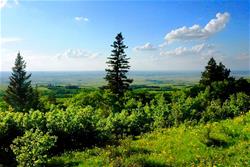
Cypress Hills – Grasslands Park Birding Tour
Grasslands National Park, Cypress Hills Interprovincial Park, Cypress Hills
May 10, 2024 to Nov 15, 2024
Join experienced local birding guide, Stan Shadick from Saskatoon Custom Bird Tours, for a 7-day / 6-night birding tour visiting Saskatchewan's Great Sandhills, Cypress Hills and Grasslands National Park. Both novice and experienced birdwatchers are welcome. The tour takes in the best birding hotspots in southwestern Saskatchewan.
STARTING AT: $ 975
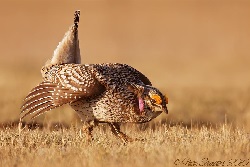
Dancing Grouse Photography Tour
Apr 19, 2024 to May 5, 2024
Join experienced local birding guide, Stan Shadick from Saskatoon Custom Bird Tours, for an early morning or evening escorted self-drive tour to view the spectacle of dancing sharp-tailed grouse near the edge of Saskatoon. This 4-hour tour, offered in the spring, is ideal for bird photographers. Package price is based on groups of 1–4 persons using their personal or rented vehicle.
STARTING AT: $ 390
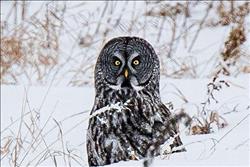
Forest Owl Photography Tour
Prince Albert National Park
Jan 1, 2024 to Mar 31, 2024
Join local birding expert, Stan Shadick with Saskatoon Custom Bird Tours on a 1- or 2-day self-drive escorted Forest Owl Photography Tour. Travel from Saskatoon to Prince Albert National Park and adjacent forests to seek out the majestic Great Gray Owl. This tour is ideal for bird photographers. Inquire about other Northern Owl Adventure Tours during the winter including snowy owl viewing options.
STARTING AT: $ 590
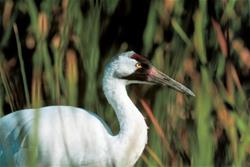
Last Mountain Lake Bird Sanctuary Day Tour
Last Mountain Lake National Wildlife Area, Saskatoon, Simpson
May 10, 2024 to Oct 30, 2024
Internationally recognized, Last Mountain Lake National Wildlife Area is a migration stopover point in spring and fall for hundreds of thousands of waterfowl, cranes and countless smaller birds, and a summer nesting area for over 100 species, including several rare species. Join Stan Shadick with Saskatoon Custom Bird Tours on this Last Mountain Lake Bird Sanctuary Day Tour with two great options from Saskatoon, Regina, Moose Jaw, Yorkton or Prince Albert. The tour is suitable for novice and experienced birdwatchers and includes an 8-hour self-drive escorted birding tour from Saskatoon with a visit to the Last Mountain Lake Bird Sanctuary plus nearby hotspots. Participants from other cities will meet on site. Package price is for 1-4 persons travelling in a single vehicle and includes guiding services. An optional 3-hour evening extension permits viewing birds at the optimal time for photography with the sun low in the sky.
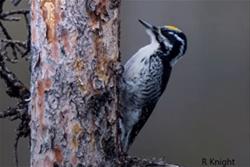
Prince Albert National Park Birding Tour
Prince Albert National Park, Saskatoon, Rosthern, Prince Albert, Nisbet Provincial Forest
Dec 1, 2023 to Nov 30, 2024
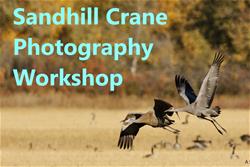
Sandhill Crane Photography Workshop
Oct 12, 2024 to Oct 14, 2024
STARTING AT: $ 1590
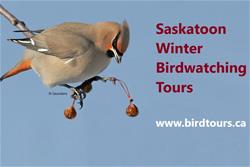
Saskatoon Winter Birdwatching Tours
Nov 15, 2023 to Mar 31, 2024
STARTING AT: $ 45
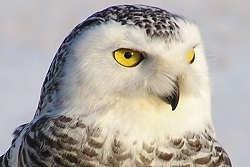
Snowy Owl Tour
Dec 1, 2023 to Feb 28, 2024
The Saskatoon Custom Bird Tours, Snowy Owl Tour is an escorted self-drive tour through a rural Saskatoon farming district reputed by owl experts to have the highest concentration of wintering snowy owls in the world! Other possible birds sightings during trip include golden eagle, gyrfalcon, prairie falcon, sharp-tailed grouse, gray partridge, snow buntings, common redpoll, common raven, bohemian waxwing and black-billed magpie. Package price is for a guided half-day tour for 1-4 persons travelling in a single vehicle and use of shared spotting scope. Inquire about full-day tour options.
STARTING AT: $ 290
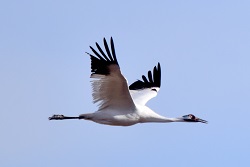
Whooping Crane and Sandhill Crane Viewing Tour
Sep 19, 2024 to Oct 25, 2024
Led by renowned birder, Stan Shadick, Saskatoon Custom Bird Tours offers four exciting options for whooping crane and sandhill crane viewing in the fall. Join a half-day, full-day or 2-day escorted, self-drive tour. For best viewing, a spotting scope is available to participants. This tour is ideal for low-mobility clients because they may remain in their vehicle during this driving tour. Package price is for 1-4 persons travelling in a single vehicle and includes guiding services and shared use of spotting scope. Sandhill crane viewing only - starts at $390 for up to 4 persons for a half-day tour.
STARTING AT: $ 490
Tours occur between 5 a.m. and 11 p.m. Check website for more information.

Rates And Discounts
Bird guiding fees $65/hr and $0.50km, 3 hour minimum.
Need Awards field
- Country / Rural
- Guided tour
- Step-on guide service
- Birding / Wildlife viewing
- Birdwatching
Maps & Docs
Contact info.
Phone(s): 306-652-5975 | 306-281-2215 | [email protected]
Tours are based out of Saskatoon.
Latitude: 52.126° N, Longitude: -106.648° W
Location Information
lat. 52.126° N, long. -106.648° W
Phone: 306-652-5975 | 306-281-2215 | [email protected]
STARTING AT: $690
STARTING AT: $975
STARTING AT: $390
STARTING AT: $590
Join a private tour or a public group tour with a small group of birders on a special 3-day / 2-night Prince Albert National Park Birding Tour. Visit the best birding hotspots in this forested Saskatchewan park, home of Grey Owl, one of Canada's first conservationists. The tour will also make stops at Nisbet Forest and Fort Carleton Provincial Park. Your leader will be Stan Shadick with Saskatoon Custom Bird Tours. All proceeds support Living Sky Wildlife Rehabilitation. Some of the special unique birds in Prince Albert National Park include spruce grouse, osprey, bald eagle, Canada jay and many species of warbler. Both novice and experienced birdwatchers are welcome. A loaner pair of binoculars may be available if requested. The leader will bring a spotting scope to allow you to view the birds under high magnification. Package price includes guiding services for each group of 1-4 persons travelling in a single vehicle.
STARTING AT: $1590
Join a Sandhill Crane Photography Workshop led by Saskatchewan wildlife photographer Boyd Coburn in Saskatoon. Witness the thousands of sandhill cranes that visit this region every fall. There will be four outdoor photography sessions with hands-on help with camera settings plus an indoor photo editing session. There will also be a special Whooping Crane tour for participants. Registration limited to five participants. Early booking suggested. A post workshop tour to the famous Last Mountain Lake Bird Sanctuary is also available.
STARTING AT: $45
Join Stan Shadick of Saskatoon Custom Bird Tours for a walk through Saskatoon's best bird-rich city parks. Look for winter visitors such as Bohemian waxwings, crossbills, chickadees,red-breasted nuthatch, white-breasted nuthatch, woodpeckers and common goldeneye. Both novice and experienced bird watchers are welcome. A loaner pair of binoculars may be available if requested. The leader will bring a spotting scope to allow you to view any ducks and geese on the river.
STARTING AT: $290
STARTING AT: $490
Related Documents

ROCKPORT BIRDING AND KAYAK ADVENTURES
Whooping crane & coastal birding tours in rockport, tx.
- Most Popular!
Whooping Crane & Coastal Birding Tour
This Texas Boat Safari guarantees you’ll see whooping cranes and we typically point out 30 to 60 different species during our 3-hour trip. Capt. Tommy and his experienced guides will teach you as much as you want to learn on how to ID some of the over 400 species that have been documented along the Texas Coastal Bend.
- Hour Glass 3 Hours
- Tags Winter
- Hour Glass 1.5 Hours
- Tags Summer
Aransas Bay Dolphin Watching Cruise
See Dolphins, Birds, and learn how local Shrimp are caught!
Sunset Cruise
See nesting birds and other wildlife along San Jose Island’s smooth waters before catching the sunset over the bay!
ROCKPORT-FULTON TOURS & RENTALS
Rockport Adventures specializes in Whooping Crane Tours and Coastal Birding aboard our flagship Skimmer. Dolphin Watching Tours and Sunset Cruises are offered in the Summer months and private tours are always an option. Inland Birding Tours provide our customers the opportunity to really see the vast array of species habitat our area has to offer.
Since 2003, Capt. Tommy Moore has been providing a truly unique nature tourism experience in the Rockport-Fulton area. Nature lovers from all over the world have given us our most prized accolades by referring their friends, families, colleagues, and folks they meet on the trail. Capt. Tommy has been in the Aransas area for over 30 years. His knowledge of the area, the incredibly abundant wildlife, and the rich history of Aransas bay give our customers a perspective of the area they cannot get anywhere else. We are a classic family business and care about our customers.
DOLPHIN, SUNSET, & BIRDING TOURS
Learn More »
KAYAK, SUP, & CART RENTALS
6-passenger golf cart rental.
Grab a cart and see the town!
- Tags Rentals
LOOKING FOR AN EXCITING EXPERIENCE IN ROCKPORT, TEXAS?
The Rockport-Fulton area is rich with Texas History. Our History Tour by golf cart is a fun way to see the area and take in it’s abundant heritage. Kayak, Paddleboard, and Golf Cart Rentals round out our offerings for the enabled visitor to really experience the most beautiful spot on the Texas coast.
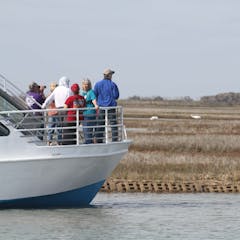
If you want to shop birding apparel or other items hit the shop button.
Rated #1 of 23 tours in rockport, tx.
We went out on a morning dolphin watching cruise and learned a lot about shrimp boats too. We say a lot of dolphins and even a baby!! The dolphins were incredible and the captain was extremely knowledgable and entertaining!!
Cpt Tommy does a great narration and is an expert on finding Whooping Cranes. His boat, the Skimmer, is ideal for Whooping Crane tours. He also shows off a lot of other species en route to and from the Whooping cranes. Tell him Keith at Alamo Inn B&B Gear & Tours sent you and he will treat you very well. We recommend him.
I've taken groups on this boat trip at least a dozen times over the years and I am never disappointed. Captain is a total professional, knows his stuff, and takes you to the birds you want. It was a chilly day on the boat, but the crew was exceptionally attentive - constantly bringing hot beverages and treats all around the boat. This is a well run operation and I cannot recommend it enough. Thanks for another great experience!
What a beautiful way to spend a morning! Captain Tommy was a capable and knowledgeable guide and took us to several different birding areas. We were treated to a whooping crane family on our cruise. This is a magnificent way to see the waters around Rockport-Fulton as well as the Aransas refuge. I highly recommend it.
A trip aboard the Skimmer with Captain Tommy, soaking in the beauty of the Texas coast is a must-do experience. Tommy, Yvette, Rebecca and all the crew create a hospitable adventure that includes birds - whooping cranes, raptors, shore birds and more, but also dolphins along with history. It is a delight every time.
Get involved in the Annual Midwest Crane Count on April 13th!

International Crane Foundation
A Same-Sex Whooping Crane Pair Nests in Wisconsin
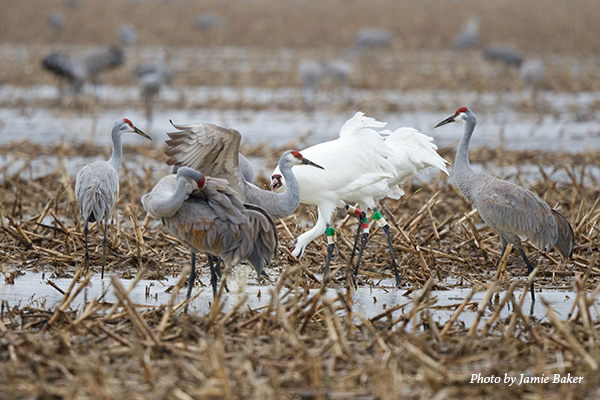
In May 2019, researchers at the International Crane Foundation documented a pair of female Whooping Cranes nesting and incubating eggs at McMillan Marsh Wildlife Area in Marathon County, Wisconsin. This observation, while exciting, was not necessarily unique as many birds, including chinstrap penguins, greater flamingoes, zebra finches, bearded vultures, and even Black-necked Cranes, have been known to exhibit same-sex pairing behaviors. However, a close record of this behavior may help us better understand how Whooping Cranes select their mates and divide incubating duties. In 2019, our team at the International Crane Foundation carefully took record of this pair’s behavior, compared incubating behaviors between male-female pairs, and attempted to understand what is truly driving these same-sex pairings.
Across species exhibiting same-sex pairings, the following hypotheses to explain this behavior have been proposed:
- The birds are breeding in a sex-skewed population where they are in the majority, so finding a mate of the opposite sex is more difficult.
- The birds are breeding in a population where it is very difficult to distinguish a male from a female.
- The birds in same-sex pairings are younger, practicing important breeding, nesting, and incubating behaviors until a mate becomes available.
- The two birds are closely related, and it is in a bird’s best interest to help their relative successfully raise a chick and pass on their genes.
All four of these hypotheses are strong assumptions for why same-sex pairings exist. However, what we observed with the female-female pair at McMillan Marsh Wildlife Area ultimately led us to a different conclusion.
So, let’s take a step back and take a closer look at this female-female pair of Whooping Cranes nesting in Wisconsin. In 2019, our team found 2-15, a four-year-old female Whooping Crane, and 28-05, a 14-year-old female Whooping Crane, sharing a nest with two eggs. Upon this observation, our interest was piqued, and to gather more information about the pair, we set up a nest camera to record their behaviors from May 14 to June 4, when the nest was eventually abandoned.
Ultimately, we found that their behaviors were very similar to a male-female pair. They spent a similar amount of time incubating the eggs on their nest (99.7%), they showed territorial behaviors when we approached the nest, and both females shared incubation duties – changing who is incubating every 3-3.5 hours even in the middle of the night, and they even unison called three times!
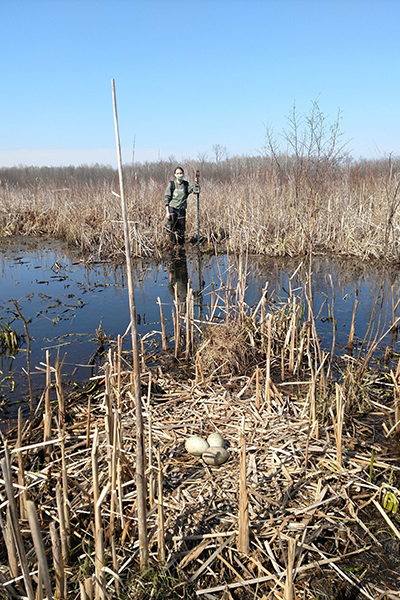
These findings were interesting and suggested the female-female pair should be able to hatch a chick if given a fertile egg, which we tried in 2020 when they nested again. As predicted, this pair did hatch a chick. Unfortunately, the chick did not survive long, and 28-05 passed away shortly after. 2-15 then was moved permanently into captivity following a wing injury, ending our work with this pair.
The final question, then, was what caused this unique pairing? As you remember from our hypotheses above, we had four potential drivers to explore.
- The first, being a sex-skewed population, was quickly debunked. The Eastern Migratory Population, which breeds in Wisconsin, has more females than males. Under this assumption, a female-female pair would only exist if there were more males than females.
- Our second assumption was that males and females were difficult to tell apart, which at first glance may appear true. However, because Whooping Crane males and females display very different behaviors that make it easy to identify their sex, we also know this assumption cannot be true.
- Moving to our third assumption, the pair is practicing until they find a mate; we also know this to be untrue. In 2017, a young male Whooping Crane was released near the pair, and the three spent time together on migration while wintering and while back in Wisconsin. The male was even observed near the pair in 2019 when they started nesting, but the pair did not attempt to claim him or any other males as a mate.
- Finally, our fourth assumption was also untrue because the two females are not closely related.
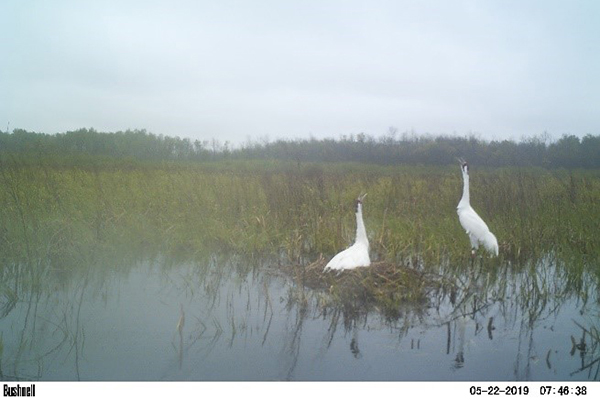
So, what do we think caused this unlikely pairing? Our biologists think this same-sex pair was created because female Whooping Cranes disperse further than males, so they found themselves in a space in Wisconsin with fewer available male Whooping Cranes, and their elevated hormones in the spring encouraged them to breed with one another.
In conclusion, the research our team shared after monitoring this same-sex pair of Whooping Cranes in Wisconsin has helped us to start to understand what drives pair-bonding in Whooping Cranes. Still, future research is needed to truly understand how this behavior will impact the future breeding success of this small, reintroduced population.
We thank Hillary Thompson and Nicole Gordon, the authors of the summarized manuscript “First Description of Nesting Behavior of a Same-Sex Pair of Whooping Cranes (Grus americana) in the Reintroduced Eastern Migratory Population,” for providing us with permission to share their work.
References:
- Thompson, H. T., Gordon, N. M. (2020). First description of nesting behavior of a same-sex pair of Whooping Cranes (Grus americana) in the reintroduced eastern migratory population . Waterbird 43(3-4): 326-332.
Story submitted by Stephanie M. Schmidt, Whooping Crane Outreach Coordinator, and Caitlyn Hughs International Crane Foundation .
JOIN THE FLOCK
Make a donation.
The International Crane Foundation is working worldwide to conserve cranes and the places they – and we – need to survive. We can’t do this important work without you!
SUBSCRIBE FOR UPDATES
Receive news about our global programs, events and more.
Receive news about the International Crane Foundation's global programs, events and more. We do not share or sell our email lists – ever.
Saskatchewan Whooping Cranes with Canadian Geographic Trip Report 2023
Guides: Dominic Cormier and Alvin Dyck
Appropriate for a Whooping Crane Tour, we started and ended with the stars of the show! We enjoyed plenty of quality time with Whooping Cranes, spotting at least 68 of these magnificent birds. We watched them dance and call, feed in the stubble fields, and poke around at fairly close range in a slough. We even had a few close flyovers! In addition to the cranes, we had incredible spectacles of Snow Geese, an abundance of other waterfowl, and an idyllic stay in Prince Albert National Park immersed in the fall colours of the Boreal forest. Here is a day-by-day account of our trip.
Our first evening we gathered at the hotel for a meet-and-greet and dinner. A few guests had some nice sightings along the South Saskatchewan River prior to meeting, while others had made long drives with great anticipation for the coming days. We all went to bed with thoughts of Whooping Cranes, and for some, the idea of all the new bird species they would encounter on this, their first bird tour!
The first morning dawned with a cold north wind and eager birders. Whooping Cranes stopover in Saskatchewan during their fall migration from Wood Buffalo National Park to the gulf coast of Texas. Marcelin, an hour NW of Saskatoon has been the preferred area for a number of years. Arriving there, we enjoyed our first Whooping Crane sighting of two adults and a rusty-coloured colt. The goose migration was in full swing, and guests learned the differences between Snow and Ross’ Geese, and Canada and Cackling Geese. The numerous Greater White-fronted Geese were also a highlight.

Adult and a Juvenile Whooping Cranes in flight
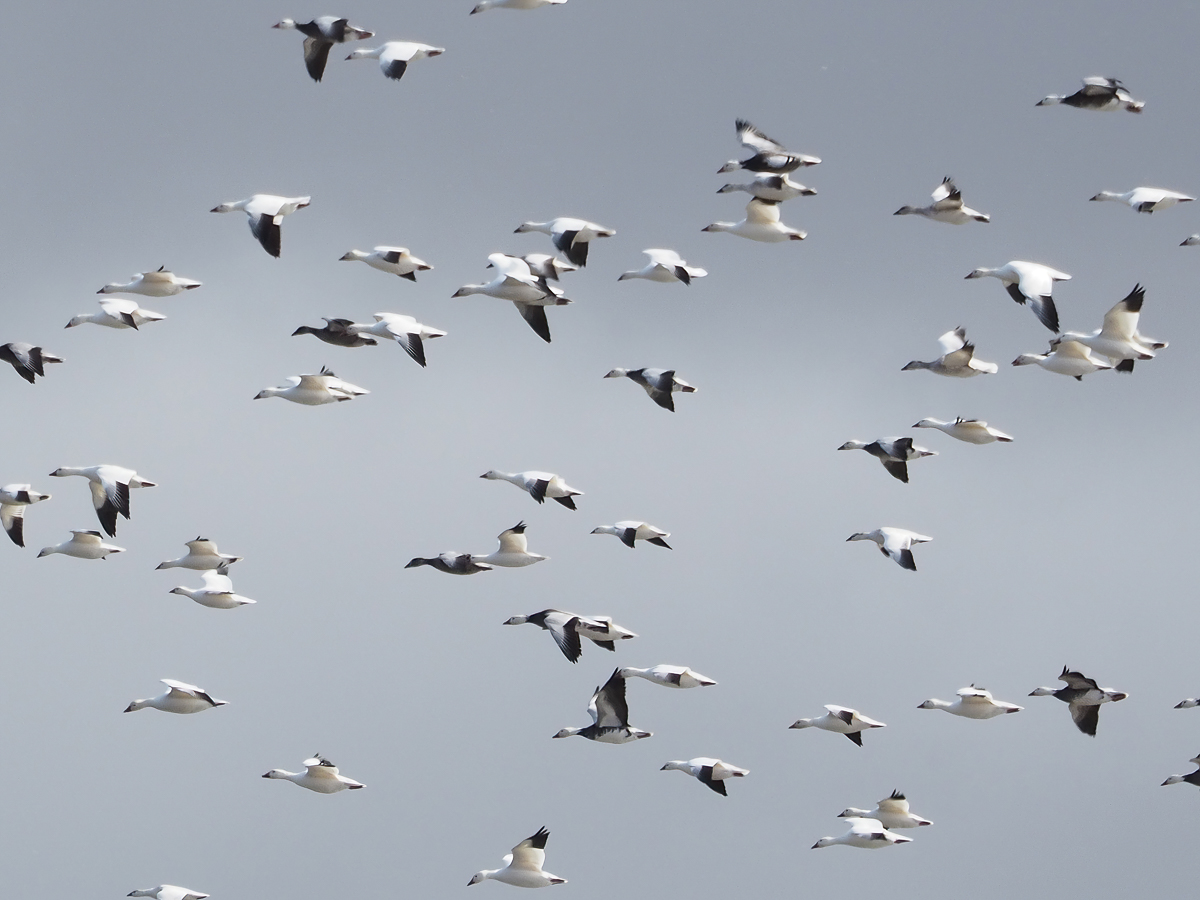
Snow and Ross’ Geese in flight © Chantal Imbeault
Finding a small wetland, we arrived just in time for 21 Whooping Cranes to fly-in and make the slough their resting area for the next hour or so. Sheltered from the north wind by our vans, we soaked up these superb birds at close range! For their part, sheltered by the tall cattails on the edge of the slough, the cranes preened, probed the water, danced, called, and simply rested between forays for leftover grain in the stubble fields.
We were close enough to see that a couple of the adult cranes were sporting both coloured leg bands, and satellite transmitters. A group of Sandhill Cranes obliged us by joining their endangered cousins. Tundra Swans, their pure white plumage glinting in the sunlight, cruised over our stakeout, and the ever present geese flocks came and went.

Whooping Cranes fighting the wind! © Chantal Imbeault
By lunchtime, we were on the road to Prince Albert National Park to spend the evening and the following day in the Mixed and Boreal Forest. Stopping at Emma Lake to stretch our legs and we all got our first taste of snow for the year. Not deterred by the white stuff, we found a mixed flock of sparrows, some Pine Siskins, and a few Bonaparte’s Gulls loafing on the beach. The ensuing drive through the park to Waskesiu was punctuated by roadside Horned Larks in the middle of the forest, curious Canada Jays, and upon arriving in town, Elk! A great way to end an action packed first day!

Elk in Waskesiu © Chantal Imbeault
Today we had the whole day to explore and enjoy Prince Albert National Park. The fall colours and a calm morning painted an idyllic scene, and a bull Elk first thing after breakfast highlighted the picture. We took a drive along the south side of Waskesiu Lake to the Narrows Campground. Along the way we enjoyed views of Pied-billed Grebe and Rusty Blackbird. We stopped to take in the fall colours and get a group photo just in time for a Pileated Woodpecker to make its presence known with its far carrying call.
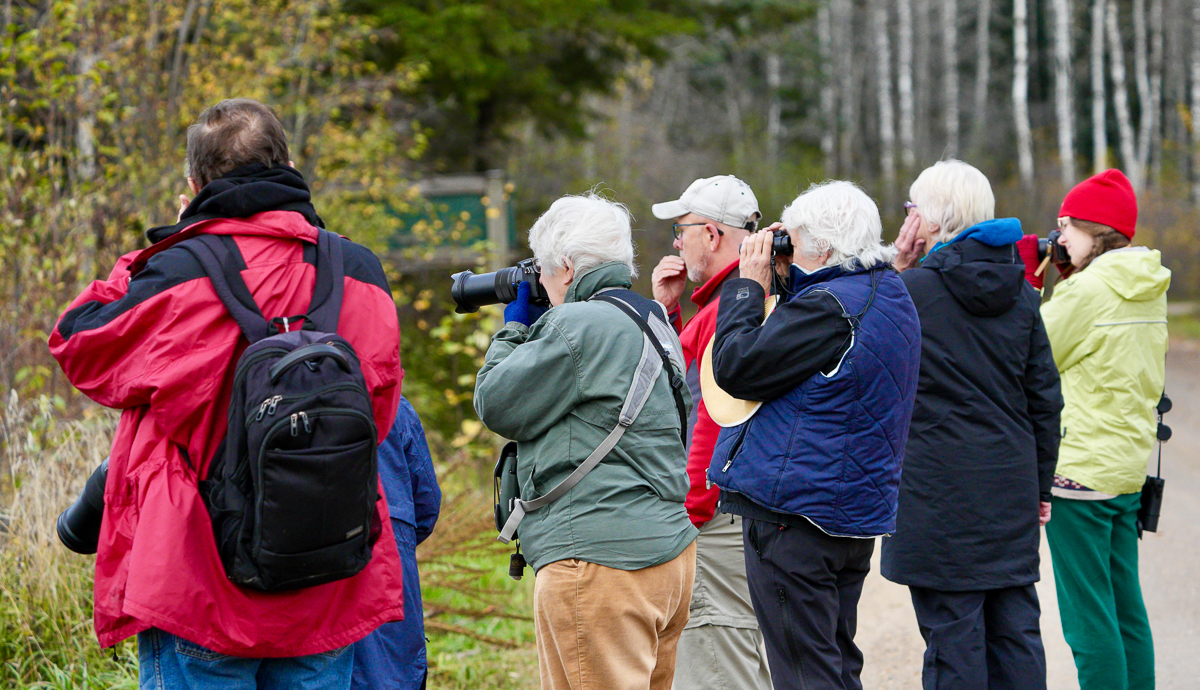
Birding in Prince Albert National Park © Carol Patterson
At the campground, we were greeted by a friendly Red Fox, Canada Jays, and a Black-billed Magpie. The Jays were determined to extract a food tax from us, delighting with their inquisitive nature. Hooded Mergansers on the calm waters pried our attention away from our begging friends, who returned once we broke out the snacks. The drive back to Waskesiu had a flyby American Three-toed Woodpecker, reminding us that not all birds are as cooperative as the Canada Jays, or the male Ruffed Grouse we had just seen in full display along the roadside!
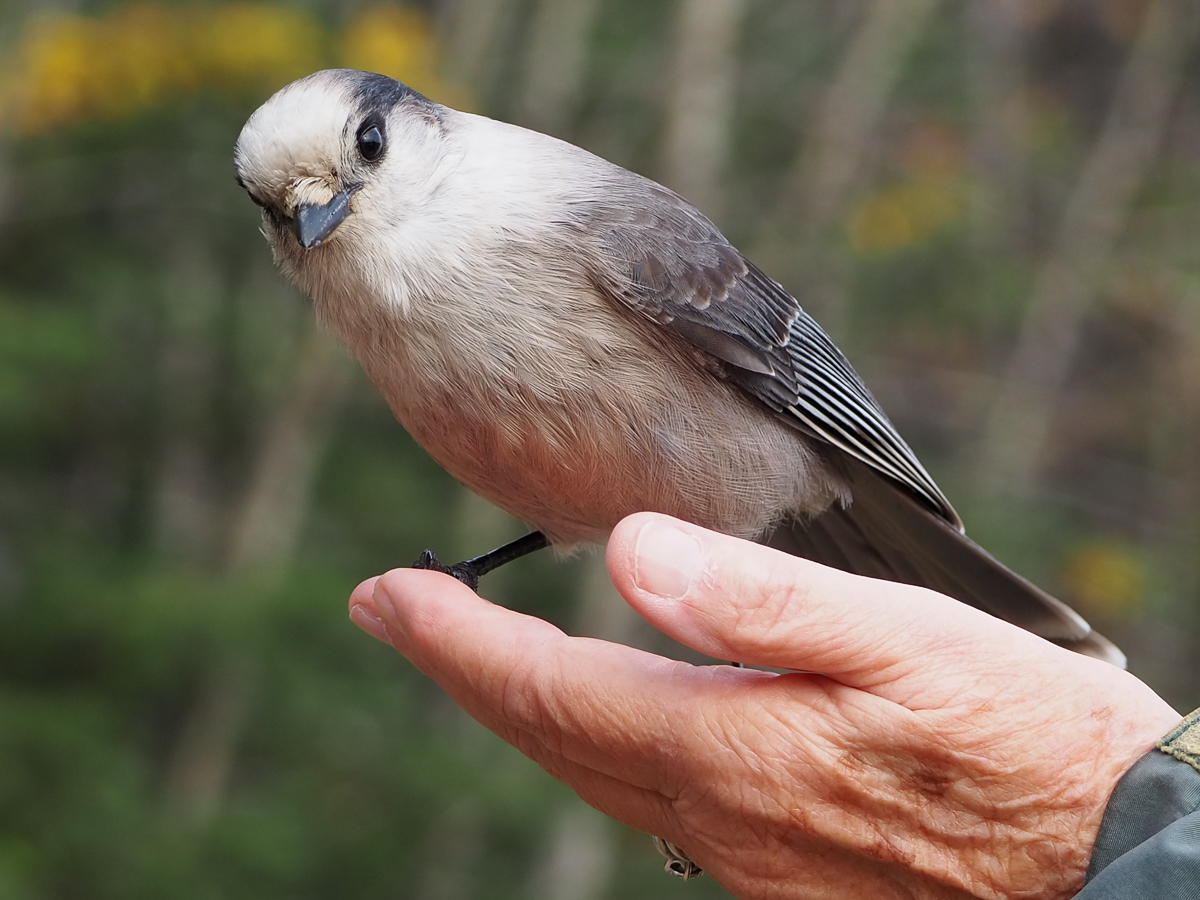
No food here! © Chantal Imbeault
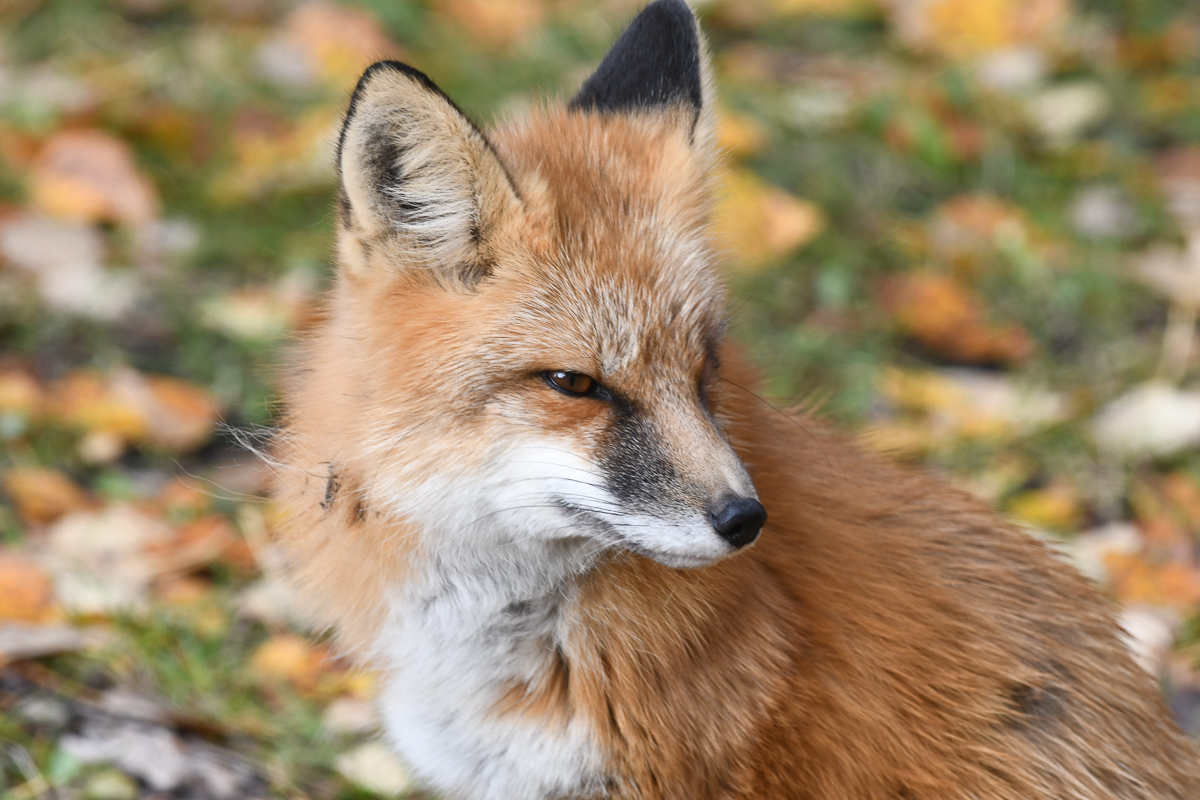
Red Fox © Dominic Cormier
No trip to the Boreal forest is complete without seeing its great engineer, the iconic Beaver. Great close-ups were had as Alvin discussed Beaver ecology to a rapt audience. A walk on the Red Deer trail allowed us close-up views of Boreal Chickadees. We made our way south along the scenic drive, spotting an obliging Porcupine, and climbing the Height-of-land Tower to take in the stunning landscape from a bird’s perspective. It was also a great reminder that not all of Saskatchewan is flat!

Porcupine © Marie Jordan

Fall colours of Prince Albert National Park © Chantal Imbeault
We started off the day with a nice walk along the South Saskatchewan River in Saskatoon. Saskatoon has done a wonderful job of preserving the waterfront, with most of it being a mix of parkland, native riparian forest, and open greenspace. Our group was very thankful for the wild space to explore, as were the Dark-eyed Juncos, Orange-crowned Warblers, Yellow-rumped Warblers, White-breasted Nuthatch, Downy Woodpecker, and other songbirds we found. The walk to the Weir was slowed to photograph the many Least Chipmunks and their food-gathering antics, as well as a nice side-by-side comparison of a California Gull with the more numerous Ring-billed Gulls. A walkway on the rail bridge crossing the river gave us sweeping views of the city, and another California Gull harassing a Ring-billed Gull for its breakfast added to the excitement.

Orange-crowned Warbler © Chantal Imbeault
At the Forestry Farm Park, many Pine Siskins feeding in the birches, a number of Brown Creepers creeping their way around, Ruby-crowned Kinglets refusing to perch quietly, and a Hermit Thrush in the open were highlights.
At Blackstrap Reservoir south of town, some lingering American White Pelicans did not disappoint as they lounged on a small sandbar. With a marked turn in the weather making it feel positively tropical, we enjoyed a picnic lunch on the shores of the lake with the sun on our faces and the company of not one, but two Townsend’s Solitaire. As it turned out, we weren’t the only creatures enjoying the sunny weather. Hordes of Boxelder bugs resolutely guarded the port-a-potties until Alvin’s brave actions cleared the way for the more wary guests.

American White Pelicans © Carol Patterson
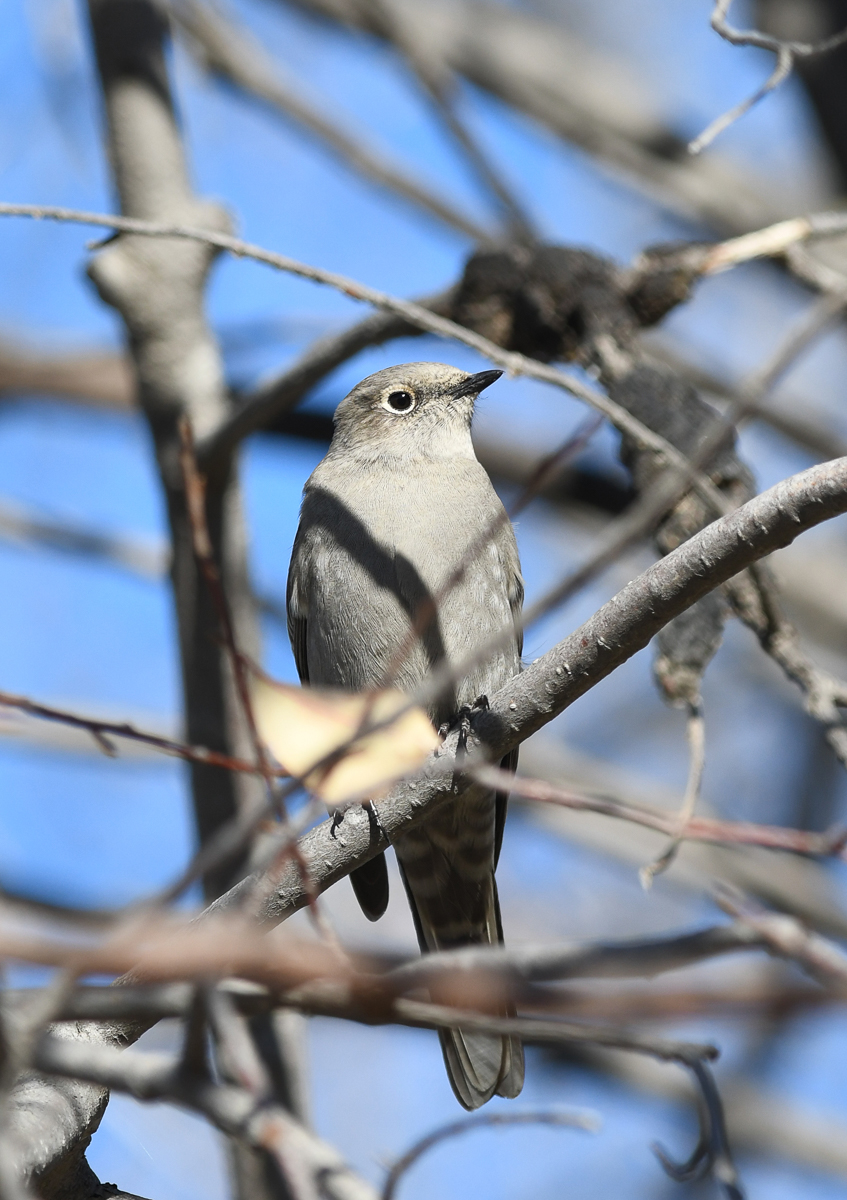
Townsend’s Solitaire © Dominic Cormier

Sunny skies on the prairies © Chantal Imbeault
East of the lake, Western Meadowlarks, Coyotes, and Mule Deer in the pastureland kept everyone’s eyes sharp, as did a calling Red-tailed Hawk and a majestic pair of Bald Eagles soaring under a blue sky. Richardson’s Ground Squirrels also thought highly enough of the improved weather to leave their subterranean lairs.
Arriving at a large slough, the sight and sounds of 50 000 Snow Geese blew our eyes and mouths wide open. The abundance of Snow Geese was both thrilling and overwhelming. A nice group of Sandhill Cranes reminded us that this is a Crane tour. Content with a day filled with sun, nice walks, and plenty of birds and mammals, we returned to the hotel for a presentation by Carol on the workings of Canadian Geographic, and some funny anecdotes of travelling around Atlantic Canada with Alex Trebek.
An early start had us watching skeins of Snow Geese under blue skies in a Tim Horton’s parking lot as we grabbed breakfast on the go, portending a bird-filled day as we returned to the Marcelin area to look for more Whooping Cranes, waterfowl, and shorebirds. Our early start paid off when we saw numerous Sharp-tailed Grouse perched atop buffalo berry bushes backed by the rising sun.
The Whooping Cranes were in their usual haunts in the fields, and we counted 66 in one scope pass. Pretty humbling to see almost 10% of the world’s population in one view! With the weather on our side, we soaked up the Whooping Crane magic, catching a few flying off to roost on Paddling Lake to the west along with some Sandhill Cranes and thousands of geese. Horned Larks and Lapland Longspurs called overhead as we watched a large Cooper’s Hawk cruise low over the fields hoping to make a meal of one of them. Wandering the area, we saw the ever dapper Thirteen-lined ground squirrel, Rusty Blackbirds, American Pipits, Northern Harriers, and a flyover of 2 Snow Buntings to remind us that despite the 20 degree weather, the shifting seasons were upon us.

Thirteen-lined Ground Squirrel © Chantal Imbeault
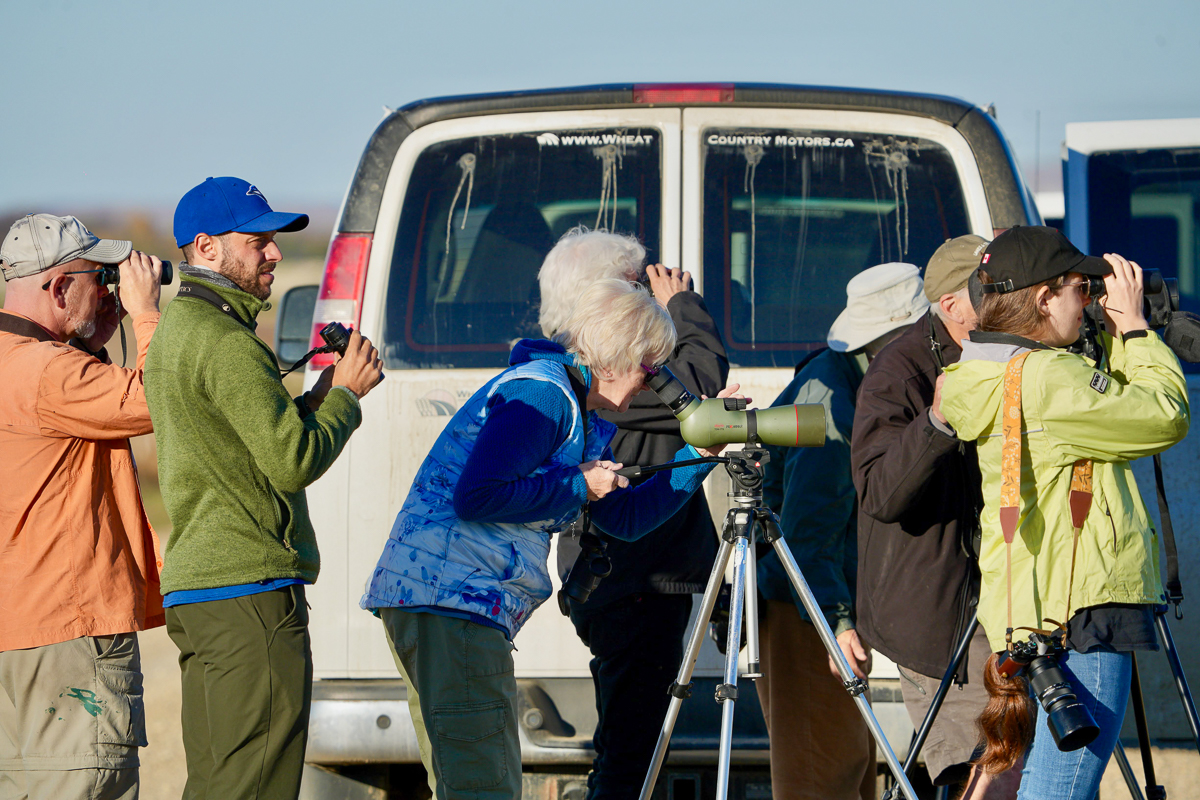
Scanning the fields © Carol Patterson
Nearby Leask Lake was teeming with life. 20 000 Snow Geese kept a wary eye on us as we got great views of American Avocets and Pectoral Sandpipers along the near shoreline. At the SW end of the lake, hordes of dabbling ducks covered the water, and I had a Black-capped Chickadee come land on my head in the middle of the open country while we scoped and identified 10 species of shorebirds, including great views of American Golden-Plover, and Baird’s Sandpiper.

American Golden-Plover © Carol Patterson
By the end of the day, we returned to the small wetland from day 1, where 20+ Whooping Cranes were once again in full view. Passing the next hour in their company, we could not have picked a better way to end the trip. With our cups full, we said our farewells to the cranes, with a last Northern Shrike on the drive home to close out the day.
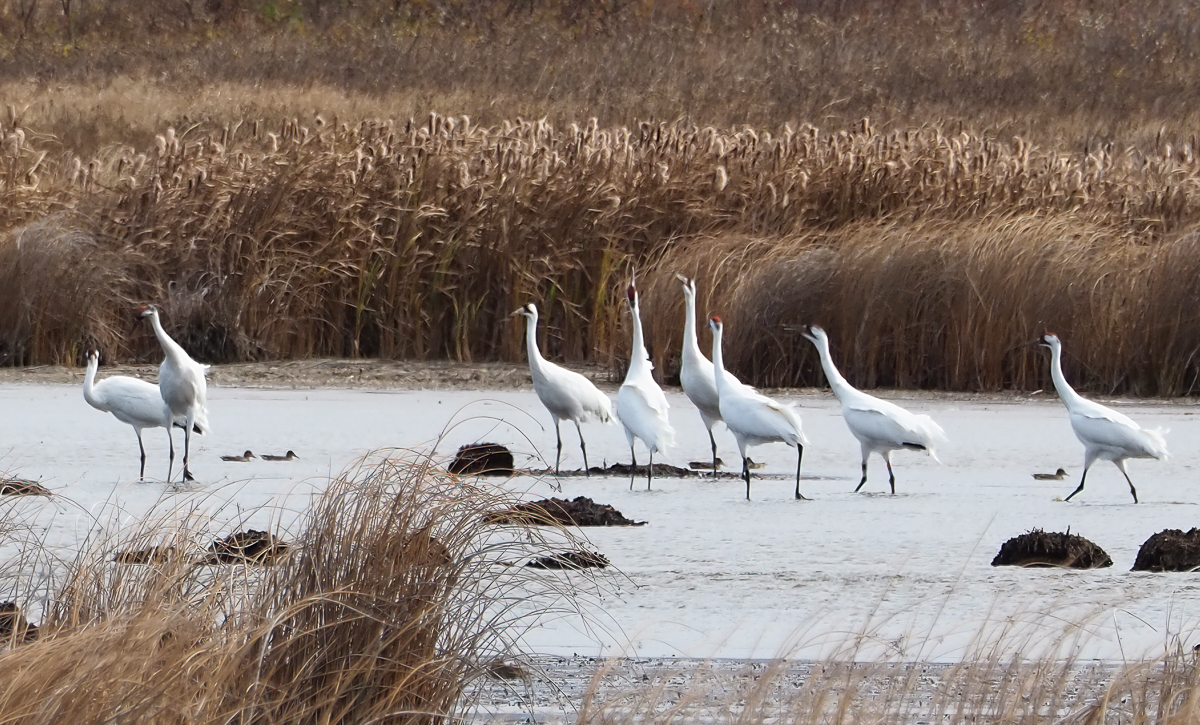
Whooping Cranes in slough © Chantal Imbeault
Alvin and I want to thank everyone for a wonderful trip! It was a great pleasure to share the spectacle that is Whooping Crane migration and so much more with all of you!
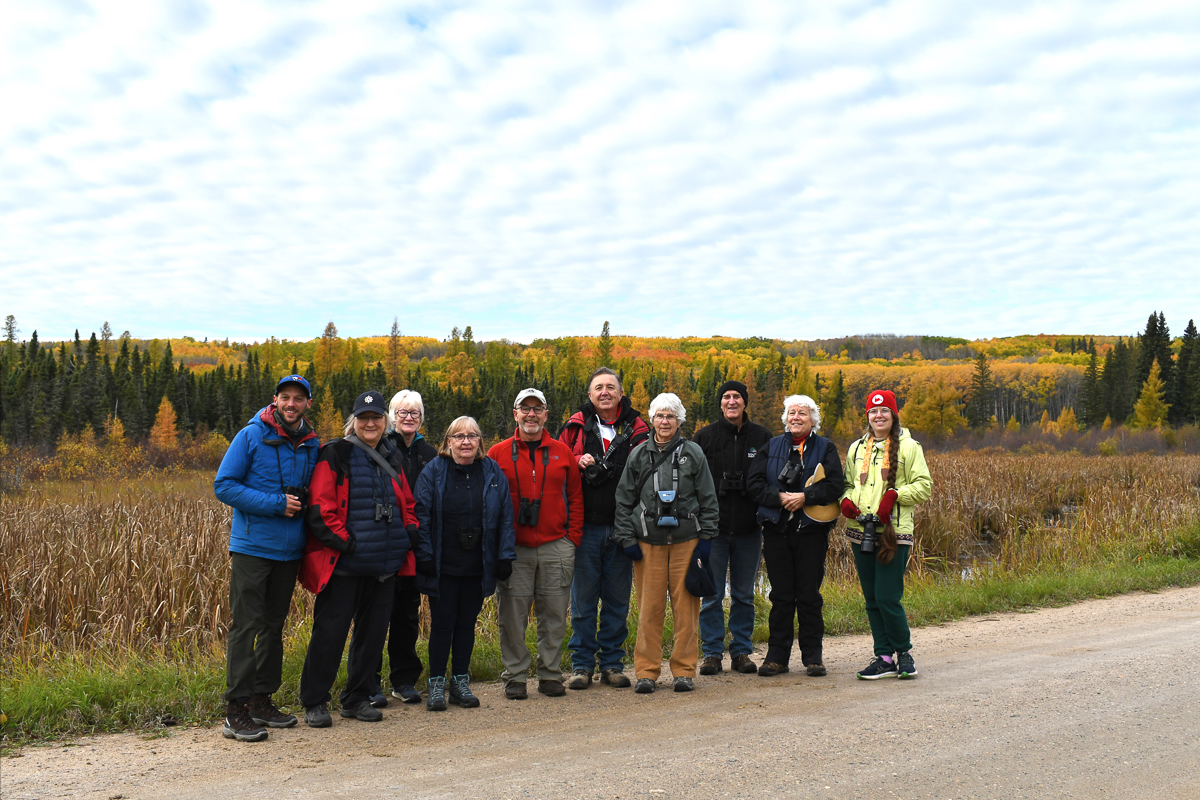
EET group 2023

Dominic Cormier
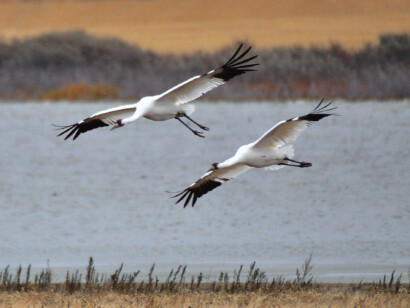
Saskatchewan Whooping Cranes with
- Conservation
- In the media
- Birding blog
- How to book
- Booking FAQs
- Plan your trip
- Land Tour FAQs
- Insurance FAQ
WHERE WE GO
- Mexico & Central America
- South America
- Australia & New Zealand

- Terms of Use
- Privacy Policy

IMAGES
COMMENTS
For many years, our Saskatchewan Whooping Crane tours led by Stan Shadick have found groups of 10 - 30 birds feeding during fall migration. In 2018, we found a single flock in excess of 150 whoopers! In 2019 and 2020, there were several flocks totaling over 100 individuals. In 2021, between 30 and 100 individuals were present during our tours ...
During our Saskatchewan Whooping Cranes birding tour, we take day trips to the surrounding prairie-pothole habitat. Most days will begin with breakfast at about 6:30 a.m., and then we leave for the day with a picnic lunch, returning in the late afternoon to our accommodation, although this will vary according to the day's activities.
What to Expect. During our Saskatchewan Whooping Cranes birding tour, we take day trips to the surrounding prairie-pothole habitat. Most days will begin with breakfast at about 6:30 a.m., and then we leave for the day with a picnic lunch, returning in the late afternoon to our accommodation, although this will vary according to the day's activities.
Saskatchewan Whooping Cranes. Sep 30 - Oct 4, 2024 (5 Days) Prices From $1,395 USD. Land Tour. View Tour. Despite some challenging weather and road conditions, our tour was a great success on many levels. Of course, the Whooping Cranes were the stars of the show, and they did not disappoint! In all we saw 68 "Whoopers" and added an ...
Itinerary. This 2-day guided birdwatching tour will visit resting locations where large concentrations of 5 species of geese and 2 species of cranes plus swans gather to feed. DAY 1 will focus on looking for the majestic Whooping Crane, the tallest bird in North America. It has been the symbol of wildlife conservation in North America for decades.
Tour Information Dates: October 3-8, 2024 (5 days) These tour dates have been selected to coincide with the peak of Whooping Crane and waterfowl migration through central Saskatchewan. Start/End: Saskatoon This tour will start and end in Saskatoon, Saskatchewan.
We have a good chance of finding whooping cranes on our birding tour as there is a fine network of field observers scouting the area for these legendary birds. Along with cranes, tens of thousands of snow geese and Canada geese, with lesser numbers of Ross's, greater white-fronted and cackling geese, are pouring through, as well as other ...
Saskatchewan Whooping Cranes. In October, sandhill cranes migrate by the thousands south across southern Saskatchewan, stopping at various localities to refuel before continuing their journey. With them are a handful of whooping cranes, coming south from breeding grounds in Wood Buffalo National Park in the Northwest Territories.
October 24, 2020. Table of Contents. Whooping cranes landing in a Saskatchewan grain field. Saskatchewan is a hotspot for seeing and photographing whooping cranes, one of the rarest and most famous endangered birds in North America. Each fall these magnificent white birds migrate around 4,000 km from their nesting grounds in Wood Buffalo ...
Meadowlark Birding Tours - Saskatchewan Whooping Cranes 2021. ... Sandhill Crane. Media 10 Checklists 5. 73. Whooping Crane. Media 22 Checklists 3. 9. Black-bellied Plover. Media 1 Checklists 2. 13. American Golden-Plover. Media 1 Checklists 2. 13. Long-billed Dowitcher. Media 4 Checklists 2. 1. Wilson's Snipe.
In a world where the hustle and bustle of daily life often overshadow the beauty of nature, the 8-hour tour to view Whooping Cranes in Saskatoon offers a serene escape into the heart of Saskatchewan's wildlife wonders. As participants venture into the tranquil landscapes, the opportunity to witness these endangered birds in their natural ...
People interested in observing whooping cranes in the wild can sign up for one of the interpretive tours provided by Schroeder (306-584-9668), or Nature Saskatchewan (306-975-3042). But with a little planning, a dollop of information and a touch of good luck, the whoopers can be found without the service of a guide.
Sep 19, 2024 to Oct 25, 2024. Led by renowned birder, Stan Shadick, Saskatoon Custom Bird Tours offers four exciting options for whooping crane and sandhill crane viewing in the fall. Join a half-day, full-day or 2-day escorted, self-drive tour. For best viewing, a spotting scope is available to participants.
Saskatchewan Whooping Crane Tour (Oct 4 - 9, 2022) Day 1 - 4 October . Participants for this inaugural Eagle-Eye Tours/Royal Canadian Geographic Society Whooping Crane Tour arrived in Saskatoon bringing with them lovely albeit somewhat cool fall weather, which we enjoyed for the duration of the tour. We met in the evening in the lobby of ...
Dawn was creeping over Prince Albert National Park when I stopped to watch a muskrat emerge from Waskesiu Lake. After four days of scanning the skies on Eagle-Eye Tours Saskatchewan Whooping Crane trip, it felt weird to be looking down.I watched the small rodent probe the shoreline, wet fur glistening as small brown eyes peered back at me as I snapped pictures to share with the other people on ...
@saskatooncustombirdtours Saskatchewan Whooping Crane Tour Review.This video is a review by Calgary naturalist Brian Keating about a Whooping Crane tour he t...
Day 1 - Wednesday/Oct 6 Ken & Rudolf had spent much of the day getting ready for the group, but we had some time to pre-scout some spots around town including the river walk along the South Saskatchewan River from the hotel north to the weir/Railway Bridge before meeting the group in the Park Town Hotel lobby at 6:30 We decided to eat in-house rather than driving; food was great just took ...
Tommy, Yvette, Rebecca and all the crew create a hospitable adventure that includes birds - whooping cranes, raptors, shore birds and more, but also dolphins along with history. It is a delight every time. Rockport Adventures Specializes in Whooping Crane Tours and Coastal Birding aboard our flagship Skimmer.
Saskatchewan Whooping Crane Tour (Sep 30 - Oct 4 2022) Day 1 - 30 September Participants to the Eagle-Eye Tours Saskatchewan Whooping Crane Tour arrived in Saskatoon, bringing with them lovely weather, which was to stay with us for the duration of the tour. We met in the evening in the lobby of our hotel […]
In 2019, our team found 2-15, a four-year-old female Whooping Crane, and 28-05, a 14-year-old female Whooping Crane, sharing a nest with two eggs. Upon this observation, our interest was piqued, and to gather more information about the pair, we set up a nest camera to record their behaviors from May 14 to June 4, when the nest was eventually ...
Appropriate for a Whooping Crane Tour, we started and ended with the stars of the show! We enjoyed plenty of quality time with Whooping Cranes, spotting at least 68 of these magnificent birds. We watched them dance and call, feed in the stubble fields, and poke around at fairly close range in a slough. We even had a few close flyovers! In addition to the cranes, we had incredible spectacles of ...